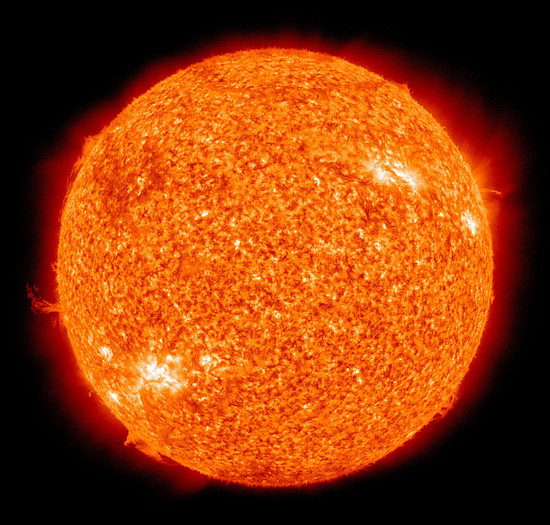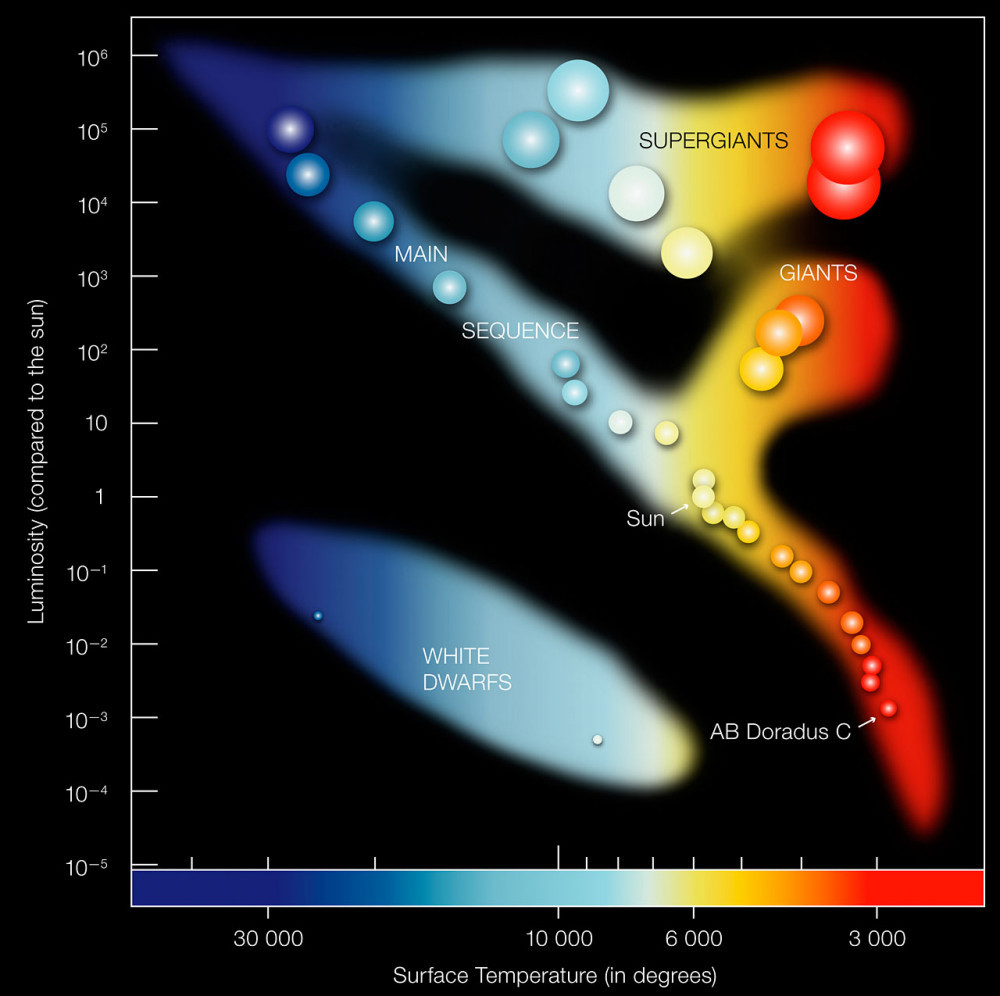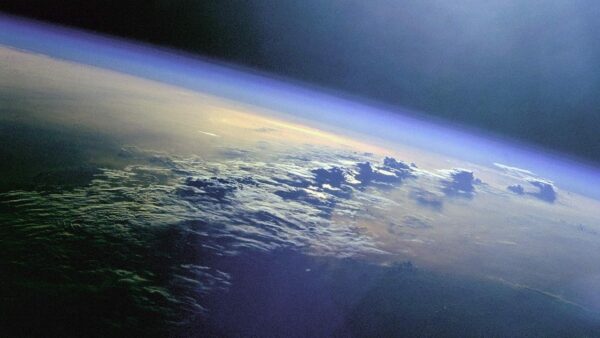The Sun is the name given to the star at the centre of our solar system. It is by far the largest object, comprising 99.8% of the mass of the entire solar system (from all the planets and moons, to the smallest debris.)
The Sun’s gravity keeps everything in the solar system, from the biggest planets to the smallest debris, in orbit around it.
Without the huge amounts of energy produced by the Sun, life here on Earth could not exist.

- How Far Away Is The Sun?
- How Did The Sun Form?
- How Hot Is The Sun?
- What Is The Sun Made Of?
- How Big Is The Sun?
- What Kind Of Star Is The Sun?
- How Much Energy Does The Sun Produce?
- What Will Happen To The Sun?
How Far Away Is The Sun?
The Sun is on average 93 million miles (150 million kilometres) from the Earth.
Just like all the other planets in the solar system the Earth has an elliptical orbit around the Sun, much like a stretched circle. This means that over the course of a complete orbit (one year), the distance between the Earth and the Sun changes.
At its closest the Sun is 91.4 million miles (147.1 million kilometers) away from the Earth. At its furthest, that distance increases to 94.5 million miles (152.1 million km).
The Sun is so far from Earth that light traveling from our home star takes 8 minutes to reach us.
How Did The Sun Form?
The Sun and the solar system, started to form around 4.6 billion years ago from an enormous cloud of dust and gas.
This cloud (or nebula) started to collapse under its own gravity, and as it did so became more dense and started to rotate.
Collisions between particles created thermal energy, and in the passing of time the core of this rotating nebula began to form a hot, dense Protostar.

The young protostar was at this stage a ball of gas not yet powered by fusion. Over tens of millions of years the cloud continued to collapse under its own gravity.
The huge pressure at the centre of the collapsing mass created such enormous temperatures that hydrogen atoms were stripped of electrons. This resulted in Hydrogen atoms fusing together to form Helium atoms and huge amounts of energy.
This nuclear fusion energy countered the intense pressure of gravity collapsing the cloud of gas. It also transformed the Protostar into the star were familiar with today. The Sun.
How Hot Is The Sun?
The hottest part of the Sun is its core, where temperatures reach 27 million °F (15 million °C), Conversely, what is regarded as the surface of the Sun, the photosphere, is a relatively cool 10,000 °F (5,500 °C).
One of the Sun’s biggest mysteries is that the Sun’s outer atmosphere, the corona, gets hotter the farther it stretches from the surface. The corona reaches up to 3.5 million °F (2 million °C), far hotter than the photosphere.
What Is The Sun Made Of ?
Unlike the Earth, the Sun is not a solid mass but a huge ball of gas and plasma held together by its own gravity.

Credit: NASA/SDO (AIA)
The sun consists mainly of the two lightest elements, Hydrogen and Helium. Around three quarters of the Suns mass is Hydrogen and the remaining quarter almost entirely Helium.
Nuclear reactions at the Suns centre constantly convert the Hydrogen into Helium, releasing immense amounts of energy in the process.
A very small percentage of the Suns mass is made up of other elements, such as Oxygen, Carbon, Nitrogen, Silicon, Magnesium, Neon, Iron and Sulfur.
How Big Is The Sun?
Compared to planet Earth, the Sun is huge. It’s around 109 times wider than the Earth.
The Earth has a diameter (from one side to the other, through the centre) of 7,926 miles or 12,756 kilometers. In comparison, the Sun is a whopping 864,000 miles or 1.4 million kilometers wide!
The Sun is so big compared to Earth that if it was hollow you could fit around 1.3 million Earths inside it! Even so, as far as size goes, the Sun is considered to be a fairly average star.
The largest known star is called UY Scuti which is around 1700 times wider than the Sun, at a mind boggling 1.48 billion miles or 2.38 billion kilometres wide!
What Kind Of Star Is The Sun?
The Sun is just like the stars that you see in the night sky. It appears so much larger and brighter though because we are so close to it.
Stars throughout the universe have a variety of colour, size and temperature. Our star, the Sun, is classed as a yellow dwarf main sequence star.
A type of graph called a Hertzsprung-Russell diagram measures each stars brightness against its temperature (or colour). The ‘main sequence’ is a region on the graph where most stars appear.
There are more than 90 percent of stars on the main sequence, and as these stars are very stable they can stay there for billions of years.

Credit: ESO
On the graph above, the main sequence appears as a band going from the upper-left (hot and bright) to the lower-right (cooler and less bright). The sun is predicted to stay on the main sequence for around 4 to 5 billion years.
How Much Energy Does The Sun Produce?
The Sun releases a mind boggling amount of energy.
Each second, the Sun fuses approximately 600 million tons of hydrogen into helium, converting about 4 million tons of matter to energy. To put that in perspective, in one second the Sun produces enough energy to satisfy the current needs of civilization for the next 500,000 years!
With the incredible rate at which energy is released, it’s all the more remarkable that the Sun is estimated to have enough ‘fuel’ left to last for the next 4 to 5 billion years!
What Will Happen To The Sun?
When the Sun starts to run out of fuel it will undergo a dramatic change.
Our star is currently in the most stable phase of its life cycle and has been this way for billions of years. Once the hydrogen stars to deplete though, the sun will move out of this stable phase.
When there is no hydrogen left to fuse in the core and all that is left is helium, a shell of fusion hydrogen will form around the core. Gravitational forces will take over, compressing the core while the rest of the sun will start to expand.
Our star will grow to be so enormous that it will envelop the inner planets possibly even the Earth. That’s when the sun will become a red giant, which it will remain for about a billion years.
At this stage the shell of fusion hydrogen around the core will deplete, leaving an abundance of helium. The helium will then fuse into heavier elements, like oxygen and carbon, in reactions that don’t emit as much energy.
The smaller amount of energy released will allow gravity to take over, and the sun will shrink into a white dwarf. All the outer material will dissipate, leaving behind a planetary nebula.

Credit: NASA.NOAH, ESA
The Helix Planetary Nebula
At 650 light-years away, it is one of the nearest Planetary nebulae to Earth.
White dwarfs are usually about the size of Earth and are the cool, dim cores of dead stars that are left behind after average-size stars have exhausted their fuel and shed their outer layers.
So, billions of years from now our star, the sun, will become a white dwarf, as will about 97% of all stars.
